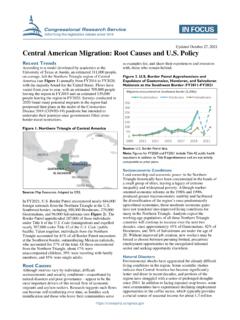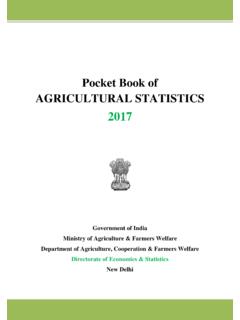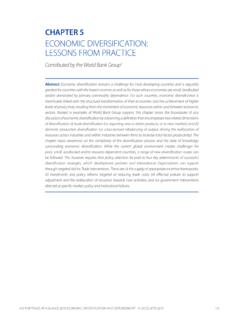Transcription of Global Research and Development Expenditures: Fact Sheet
1 Global Research and Development Expenditures: fact Sheet Updated September 27, 2021 Congressional Research Service R44283 Global Research and Development Expenditures: fact Sheet Congressional Research Service 1 esearch and Development (R&D) plays a central role in advanced economies in areas such as economic growth and job creation, industrial competitiveness, national security, energy, agriculture, transportation, public health and well-being, environmental protection, and expanding the frontiers of human knowledge Accordingly, companies, governments, universities, nonprofit organizations, and others around the world have made substantial investments in R&D.
2 Since 2000, total Global R&D expenditures have more than tripled in current dollars, from $677 billion to $ trillion in 2019. The United States emerged as a Global leader in science and technology in the second half of the 20th century. During this period, public and private investments in R&D grew rapidly and helped to propel the United States to a position of Global economic leadership. By 1960, the United States accounted for approximately 69% of the world s R&D funding. By 2019, however, the share of Global R&D expenditures2 had fallen to about 30%.3 (See Figure 1.) The decline in share of Global R&D is not the result of a reduction in R&D investments in fact , public and private R&D grew robustly during this period but rather is the result of even greater increases in the investments of the governments and industries of other countries , which have recognized the importance of R&D to their industrial innovation and competitiveness.
3 Figure 1. Share of Global R&D Sources: 1960: CRS analysis of Department of Commerce, Office of Technology Policy, The Global Context for Technology Policy, Summer 1997. 2019: CRS analysis of Organisation for Economic Cooperation and Development (OECD) data, Main Science and Technology Indicators, Notes: Rest of the World includes the members of the OECD (less the United States), as well as Argentina, China, Romania, Russia, Singapore, South Africa, and Taiwan. R&D expenditures by some others countries are not included but are likely to be small in relative terms. In estimating total Global R&D, CRS used the most 1 Alt ernat ively, some nat ions have t aken non-R&D int ensive pat hs t o economic growt h, for example by serving as low labor-cost locat ions for t he manufact uring and service needs of ot her nat ions, by licensing or acquiring t he int ellect ual propert y needed for product ion act ivit ies, and by ext ract ing and refining nat ural resources ( , oil, gas, minerals).
4 2 For purposes of t his report , Global R&D expendit ures include t hose of t he OECD count ries, as well as Argent ina, China, Romania, Russia, Singapore, Sout h Africa, and T aiwan. R&D expendit ures by some ot hers count ries are not included but are likely t o be small in relat ive t erms. 3 2019 is t he lat est year for which OECD R&D dat a is largely complet e. It generally t akes a year or t wo for nat ional R&D dat a t o be collect ed and report ed, t hen harmonized and published by t he OECD. R Global Research and Development Expenditures: fact Sheet Congressional Research Service 2 recent year s reported R&D expenditures for two countries (Argentina and South Africa) that had not reported data for 2019.
5 In 2019 (the most recent year for which comprehensive data are available), Global R&D expenditures were $ The United States continued to fund more R&D than any other country. China, ranked second in 2019, funded more R&D than the next four highest countries Japan, Germany, South Korea, and France combined. The 10 largest R&D-funding countries of 2019 accounted for $ trillion in R&D expenditures, about of the Global total; the top 20 R&D-funding countries accounted for $ trillion, of the Global total. (See Table 1.) Table 1. countries with the Highest expenditure on R&D, 2019 (in billions of current PPP dollars) Rank Country Amount Rank Country Amount 1 United States $ 11 Canada 2 China 12 Spain 3 Japan 13 Turkey 4 Germany 14 Australia 5 South Korea 15 Netherlands 6 France 16 Sweden 7 United Kingdom 17 Israel 8 Russia 18 Switzerland 9 Taiwan 19 Belgium 10 Italy 20 Poland Source: CRS analysis of Organisation for Economic Development and Cooperation, database, Notes: PPP = Purchasing Power Parity.
6 PPP is used to determine the relative value of different currencies and to adjust data from different countries to a common currency allowing direct comparisons among them. Australia and Switzerland based on 2017 data. Figure 2 illustrates R&D expenditures between 2000 and 2019 for the 10 countries with the highest R&D expenditures. 4 Includes OECD members, plus Argent ina, China, Romania, Russia, Singapore, Sout h Africa, and T aiwan. (Organisat ion for Economic Cooperat ion and Development , at dat abase) Global Research and Development Expenditures: fact Sheet Congressional Research Service 3 Figure 2.
7 R&D Expenditures of Selected countries , 2000-2019 (in billions of current PPP dollars) Source: CRS analysis of Organisation for Economic Cooperation and Development , database, Notes: PPP = Purchasing Power Parity. PPP is used to determine the relative value of different currencies and to adjust data from different countries to a common currency allowing direct comparisons among them. Trends in Global R&D share between 2000 and 2019 for the 10 countries with the highest 2019 R&D expenditures are illustrated in Figure 3. Among them, six saw declines in share of Global R&D the United States, Japan, Germany, France, the United Kingdom, and Italy while four saw their shares grow China, South Korea, Russia, and Taiwan.
8 In 2000, China accounted for nearly 5% of Global R&D, joining the United States, Japan, South Korea, and the countries of Western Europe as the largest funders of R&D. In 2009, China surpassed Japan to become the second largest funder of R&D. From 2000 to 2019, while China s share of Global R&D rose from to , the share fell from to and Japan s share fell from to Figure 3. Share of Global R&D of Selected countries , 2000-2019 Source: CRS analysis of Organisation for Economic Development and Cooperation, database, Notes: Global R&D includes the expenditures of the OECD countries , Argentina, China, Romania, Russia, Singapore, South Africa, and Taiwan.
9 Share computed in PPP terms. PPP = Purchasing Power Parity. PPP is used to determine the relative value of different currencies and to adjust data from different countries to a common currency allowing direct comparisons among them. Global Research and Development Expenditures: fact Sheet Congressional Research Service R44283 VERSION 14 UPDATED 4 Figure 4 illustrates the growth of R&D expenditures for each of the 10 countries with the highest 2019 R&D expenditures for 2000 to 2019 as a percentage of its 2000 R&D expenditures. Figure 4. Growth in R&D Expenditures Since 2000 for Selected countries , 2000-2019 Source: CRS analysis of Organisation for Economic Development and Cooperation, database, Author Information John F.
10 Sargent Jr. Specialist in Science and Technology Policy Disclaimer This document was prepared by the Congressional Research Service (CRS). CRS serves as nonpartisan shared staff to congressional committees and Members of Congress. It operates solely at the behest of and under the direction of Congress. Information in a CRS Report should not be relied upon for purposes other than public understanding of information that has been provided by CRS to Members of Congress in connection with CRS s institutional role. CRS Reports, as a work of the United States Government, are not subject to copyright protection in the United States. Any CRS Report may be reproduced and distributed in its entirety without permission from CRS.

















